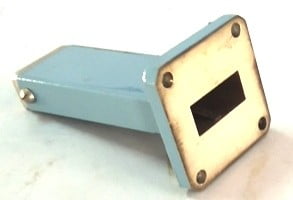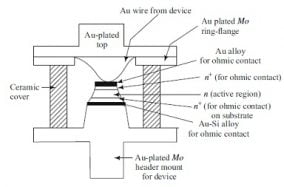Table of Contents
Waveguide Phase Shifters
Waveguide Phase Shifters: A phase shifter is a two-port component that provides a fixed or variable change in the phase of the traveling wave. An ideal phase shifter is lossless and matched. It only shifts the phase of the output wave. Example: Phase shifters are used in phased antenna arrays.
A structure resembling the attenuator in the figure below also operates as a phase shifter when the resistive cards are replaced with dielectric cards having proper lengths. Electrically controlled phase shifters are much faster than mechanical phase shifters. They are often based on PIN diodes or field-effect transistors (FETs).

Fixed Phase Shifters
Fixed phase shifters are usually extra transmission-line sections of a certain length that are meant to shift the phase with regard to the reference line. Therefore, depending on the bias current, the wave traveling along the transmission line will have an additional traveling path. Since these devices are binary switches, only discrete phase shifts are possible.
Variable Phase Shifters
The variable phase shifters use mechanical or electronic means to achieve a dynamic range of phase difference. The mechanically tuned phase shifter usually consists of variable short circuits that are used with hybrids or, in the case of waveguide components, a dielectric slab with a variable position in the guide. Step motors move the slab across the guide (from its center toward the outer walls), there by accomplishing a maximum or minimum phase shift. Another method for obtaining the desired mechanically tuned phase shift involves combining variable short circuits and hybrid circuits. The movement of the short circuit along a transmission line results in the phase shift, thus making it appear shorter or longer.
Dielectric phase shifters
Variable phase shifters in rectangular waveguides are shown in the figure below. The variable type of dielectric phase shifters employs a low-loss dielectric insertion in the air-filled guide at a point of the maximum electric field to increase its effective dielectric constant. This causes the guide wavelength, λg to decrease. Thus, the insertion of the dielectric increases the phase shift in the wave passing through the fixed length of the waveguide section. Tapering of the dielectric slab has resorted in order to reduce the reflections.

Rotary phase shifters
The precision phase shifter can be realized by a rotary phase shifter, which is useful in microwave measurement. The essential parts of this phase shifter are three waveguide sections: two fixed and one rotary. The fixed sections consist of quarter-wave plates, and the rotary section consists of half-wave plates; all the plates are of a dielectric type. The center section is rotatable to provide the required phase shift. The structure of the rotary vane attenuator is shown in the figure below.

The two fixed quarter-wave sections are identical in all respects, and the rotatable half-wave section is just the double of a quarter-wave section. Each of the two fixed sections, attached to a transition, consists of a piece of a circular waveguide with a dielectric plate, making an angle of 45° with the horizontal. The dielectric plate is usually thin with εr > 1, μr = 1. The output remains vertically polarized, which means that the phase shifter is lossless and reflection less for any position of the rotary section. It is used as a calibration standard due to its high accuracy.
Related Posts:


